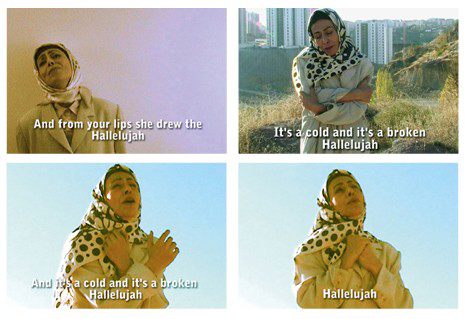- Open Today: 10.00–18.00
- Ticket
- Shop
- Membership
- TR EN

Ferhat Özgür, 1965
I Can Sing, 2008
Ferhat Özgür’s artistic practice encompasses a wide range of media, such as painting, video, photography and installation. In addition to his art, Özgür is known for his academic and curatorial works. His main topics of interest are political reality, urban environment, collective memory and resulting sociopsychological issues.
Özgür primarily explores the individual’s relationship with society in works that blend cultural and social critique with humor and irony. Focusing his observations on the city and urbanization in Turkey, he conveys in a touching way the states of mind of individuals confronted with tension, opposition and contradiction arising from change and transformation. As someone who grew up in the city’s peripheries, in a very poor neighborhood adjacent to a prison, the perspective he offers in his works is essentially that of an insider. A musical structure can often be felt in the works of Özgür, who had a semi-professional musical career during his university years. Through associations, the music he uses creates a rupture in the viewer’s memory while also generating a potential space for expressing individuality and attaining emancipation.
“I Can Sing” (2008) gave its title to his solo exhibition at MoMA in 2013. In “I Can Sing,” Özgür uses an iconic song to try and make sense of the situation of an individual in a country caught between modernization and the traditional way of life, between Islamic identity and western culture. In the video, shot in Ankara, the artist depicts an Anatolian woman among the debris of a modern housing development with unfinished landscaping built along the road to the airport. It is not just the city’s new visage that we see in the background but also the mosques and minarets that have replaced the Hittite sun as Ankara’s city symbol. The woman with traditional attire moves her lips as if doing karaoke, raises her arms as if in supplication, but instead of the woman’s voice we hear that of a man singing a song in English: “Hallelujah”. This song by famous singer-songwriter Leonard Cohen, has over three hundred covers and is considered a requiem of contemporary times. Apart from its references to Christianity, “Hallelujah” is an everyday exclamation used in Western society to express joy and gratitude when something long-awaited is realized. The version in the video sung by Jeff Buckley is a poignant performance. To cite Time magazine, Jeff Buckley treated the song “like a tiny capsule of humanity, using his voice to careen between glory and sadness, beauty and pain... It’s one of the great songs.” Indeed, like the irony between the female figure and the male voice, traditional attire and western popular music, Özgür’s video presents conflicting feelings of grief and joy and of approval and resistance in the face of change.
Film / Video
Video, color with sound
Istanbul Museum of Modern Art Collection
Acquired with Funds Provided by Genç Modern.